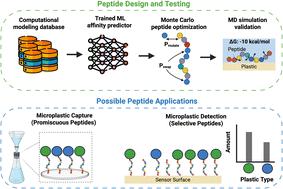人工智能驱动的混杂和选择性塑料结合肽的合理设计
IF 7.4
1区 化学
Q1 CHEMISTRY, MULTIDISCIPLINARY
引用次数: 0
摘要
由于微塑料颗粒的尺寸小,组成不均匀,因此对微塑料污染的治理具有挑战性。修复工作将受益于与微塑料污染的许多成分结合(混杂结合)以促进定量和捕获的工具,或与某些污染成分结合(选择性结合)以促进分离或降解的工具。这种作用可以由多肽填补,多肽可以选择性或混杂地与生物分子或材料结合。虽然目前已有针对单一塑料设计塑料结合肽的方法,但混杂塑料结合肽的设计却很少受到重视,而且目前还没有设计选择性塑料结合肽的方法。在这里,我们提出了一个极简但高性能的框架,将长短期记忆(LSTM)模型与模拟退火(SA)相结合,以设计混杂塑料结合或选择性塑料结合肽。我们的方法从PepBD数据(一个生物物理建模程序)中学习控制肽对不同塑料亲和力的序列函数关系。所学到的关系可以快速设计具有定制结合特性的肽,用于任意组合的塑料。我们使用LSTM-SA框架来设计(1)对五种塑料(聚乙烯、聚丙烯、PET、聚氯乙烯和尼龙)具有亲和力的混杂塑料结合肽,以及(2)优先结合一种塑料(聚丙烯)而不是另一种塑料(PET)的选择性塑料结合肽。值得注意的是,混杂的塑料结合肽是首次报道的旨在结合尼龙和PVC的设计。分子动力学模拟验证了我们设计的肽具有预测的结合行为,其中高亲和力与强范德华相互作用有关。该框架的模块化可以很容易地适应于优化肽的选择性或塑料的不同组合的混杂性。更广泛地说,这种结构可能对设计与其他固体材料结合的肽有用。本文章由计算机程序翻译,如有差异,请以英文原文为准。

AI-driven rational design of promiscuous and selective plastic-binding peptides
Microplastic pollution is challenging to remediate due to the small size and heterogeneous composition of microplastic particles. Remediation efforts would benefit from tools that either bind to the many components of microplastic pollution (promiscuous binding) to facilitate quantitation and capture, or bind to certain components of pollution (selective binding) to facilitate separation or degradation. Such a role could be filled by polypeptides, which can bind selectively or promiscuously to biomolecules or materials. While methods exist to design plastic-binding peptides (PBPs) for a single plastic, the design of promiscuous plastic-binding peptides has received scant attention, and there are no methods to design selective plastic-binding peptides. Here, we present a minimalist yet high-performing framework integrating Long Short-Term Memory (LSTM) models with simulated annealing (SA) to design promiscuous plastic-binding or selective plastic-binding peptides. Our approach learns sequence–function relationships governing peptide affinity for different plastics from PepBD data, a biophysical modeling program. The learned relationship enables rapid design of peptides with tailored binding properties for arbitrary combinations of plastics. We use our LSTM-SA framework to engineer (1) promiscuous plastic-binding peptides with affinity for five plastics (polyethylene, polypropylene, PET, polyvinyl chloride, and nylon), and (2) selective plastic-binding peptides that bind preferentially to one plastic (polypropylene) over another (PET). Notably, the promiscuous plastic-binding peptides are the first reported designs intended to bind to nylon and PVC. Molecular dynamics simulations validate that our designed peptides exhibit the predicted binding behaviors, where high affinity is linked to strong van der Waals interactions. The framework's modularity can be readily adapted to optimize peptide selectivity or promiscuity for different combinations of plastics. More broadly, the architecture may be useful for designing peptides that bind to other solid materials.
求助全文
通过发布文献求助,成功后即可免费获取论文全文。
去求助
来源期刊

Chemical Science
CHEMISTRY, MULTIDISCIPLINARY-
CiteScore
14.40
自引率
4.80%
发文量
1352
审稿时长
2.1 months
期刊介绍:
Chemical Science is a journal that encompasses various disciplines within the chemical sciences. Its scope includes publishing ground-breaking research with significant implications for its respective field, as well as appealing to a wider audience in related areas. To be considered for publication, articles must showcase innovative and original advances in their field of study and be presented in a manner that is understandable to scientists from diverse backgrounds. However, the journal generally does not publish highly specialized research.
 求助内容:
求助内容: 应助结果提醒方式:
应助结果提醒方式:


